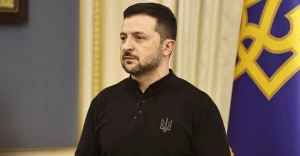
Threat from Belarus: how fast can Russia build a strike force?
Zelenskyy warns that Russia could deploy up to 150,000 troops in Belarus, raising security concerns in Europe
Is this a realistic scenario, and what is Russia's current capability to form such a strike force? Ukrainian military observer Oleksandr Kovalenko has analyzed the situation.
Cold reality check
The Ukrainian president’s words shocked many in Europe, as he openly addressed a very real threat that many in the West prefer to ignore—even after three years of bloodshed in Ukraine.
Notably, just before Zelenskyy’s speech in Munich, Denmark's Foreign and Military Intelligence Service published the "Forecast 2024" report, which warned of the risk of a Russian invasion of Europe within the next five years—or possibly even sooner.
Regardless, is it truly difficult to imagine Russia forming such a strike force in Belarus? Or is it more plausible than it seems?
Ukraine’s bitter experience
Europe should remember the past—specifically, 2022—when, under the guise of the "Union Resolve-2022" military exercises, Russia deployed a 40,000-strong force to Belarus, which then invaded Ukraine on February 24.
At the time, this was the largest Russian troop concentration ever stationed in Belarus. Nearly all these troops had full equipment and short-term reserves.
In other words, Russia has experience deploying a significant contingent in Belarus. They could do it again under the pretext of the "Zapad-2025" military exercises.
Current composition of Russian troops in Belarus
At present, there are just over 2,000 Russian military personnel stationed in Belarus. They are deployed across several sites:
- Radio-technical hub Baranovichi and 43rd communication hub Vileyka – about 1,450 personnel.
- Airfields in Baranovichi, Zyabrovka, and Mozyr – about 530 personnel.
- 313th garrison military prosecutor's office and 484th military investigative department – about 20 personnel.
- 1405th artillery ammunition base (military unit 42707, Velyka Horozha, Osipovichi district) – about 20 personnel.
- Wagner PMC – around 100 members.
Most of these troops operate air defense systems, electronic warfare (EW), and radio-electronic reconnaissance (RER) systems, as well as support personnel. In other words, they do not constitute a ground combat force capable of participating in large-scale offensive operations.
But could this force grow to the 150,000 troops mentioned by Zelenskyy? How much time would it take, and under what conditions?
Forming a Russian Strike Force in Belarus
It is important to note that, given the intensity of combat in Ukraine and Russia’s current losses, it is not feasible for Russia to quickly increase its forces in Belarus to 150,000. However, under what conditions could it be possible? The answer is straightforward: if combat operations in Ukraine cease or their intensity significantly decreases.
If we imagine a scenario where fighting in Ukraine completely stops, Russia—currently losing 45,000–48,000 troops per month in killed and wounded—would reduce these losses to nearly zero. Meanwhile, Russia would continue mobilizing 30,000–40,000 troops per month.
By the end of May, this would mean an additional 90,000–120,000 troops. By the end of August, that number could rise to 180,000–240,000. With basic training for mobilized personnel, the first batch of 90,000–120,000 soldiers would be combat-ready by June.
Even if a ceasefire does not occur, and we only see a reduction in combat intensity—leading to lower Russian losses of 10,000–20,000 troops per month—Russia's current mobilization rates would still allow it to accumulate forces and form new units, including those deployed in Belarus.
Expanding military infrastructure in Belarus
There are already signs of preparations for a military buildup in Belarus. Construction projects are underway at several military facilities with direct Russian involvement. For example, new infrastructure for personnel and equipment is being built at the 1405th artillery ammunition base in Velyka Horozha, Osipovichi district.
Therefore, if Russia intends to form a force for an attack on Europe, all it needs is a halt to active combat in Ukraine. However, this does not solve the issue of equipping these units with military hardware.
While Russia can supply the manpower for such a force, it lacks the necessary equipment. Even if the fighting in Ukraine stops, Russia’s military-industrial complex cannot fully outfit a 150,000-strong strike force. Instead, it would consist largely of infantry formations organized as marching battalions within makeshift infantry corps—essentially resembling Soviet-style rifle divisions.
Still, given how Russian commanders handle their troops, this would not be seen as a major operational or ethical issue for them. However, for countries like Lithuania, Latvia, and Estonia, it could become a serious threat—one they might struggle to counter due to NATO’s slow, bureaucratic response mechanisms.
Military-technical support from Belarus
It is also possible that Russian units in Belarus could be reinforced with equipment from the Belarusian army. This tactic was used in 2022, both during the battles in northern Ukraine and after Russian troops withdrew.
Logistics between Russia and Belarus remain highly efficient. In 2024 alone, Russia has sent 216 railcars with military cargo to Belarus, including air defense systems, ammunition, and armored vehicles for ground forces.
Conclusion
At present, Russia is suffering such heavy losses in Ukraine that it cannot pose an immediate threat to European countries. However, as soon as its losses decrease—or are eliminated altogether—that threat will escalate dramatically.
In a January article on OBOZ.UA titled "After a Year of 'Silent Guns,' the Kremlin May Reuse an Old Scenario: How Realistic Is an Invasion of Europe?" it was detailed how Russia could build up its forces if it faced no further battlefield losses.
But considering all possible scenarios, shorter timelines for forming strike groups that could extend the battlefield into Europe must also be examined. If a ceasefire or drastic reduction in Russian losses occurs, Moscow could indeed form the “strike force” Zelenskyy warned about at the Munich Security Conference—posing a real threat not only to Ukraine but also to the European Union.
- News












































